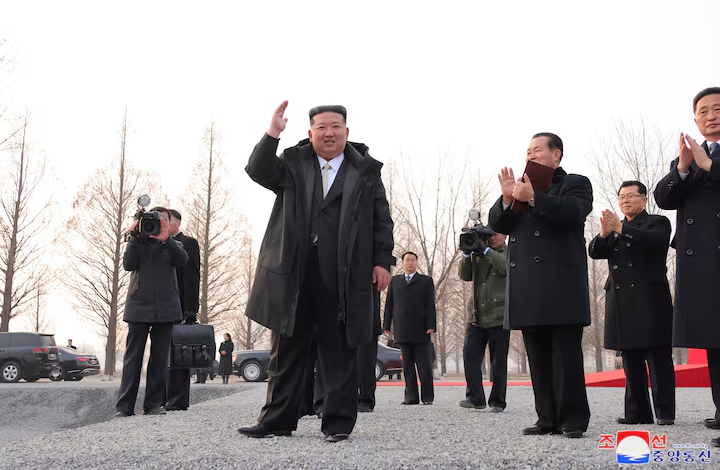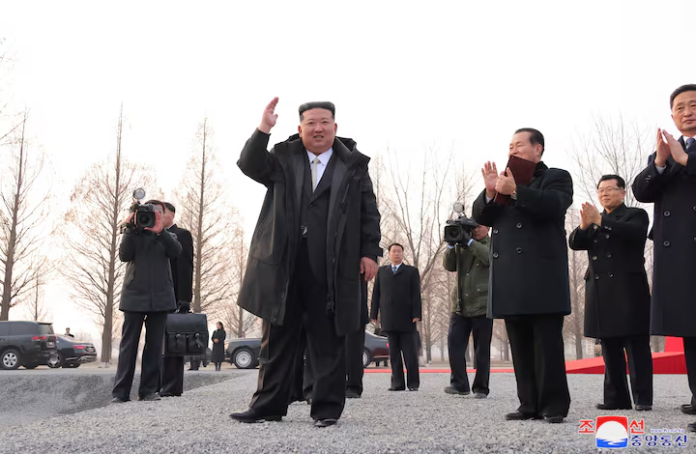North Korean leader Kim Jong Un has made a rare visit to the Kumsusan Palace of the Sun, where the embalmed bodies of his late father, Kim Jong Il, and grandfather, Kim Il Sung, are preserved. His visit, marking Kim Jong Il’s birthday on February 16, highlights the continued significance of North Korea’s ruling dynasty, despite shifting political strategies under Kim Jong Un’s leadership.
A Rare Pilgrimage to the Mausoleum
For the first time in four years, Kim Jong Un paid his respects at the family mausoleum in Pyongyang, accompanied by his sister Kim Yo Jong and other high-ranking officials. State media KCNA reported that he expressed deep reverence and reaffirmed his commitment to what he called a “sacred struggle”—a term often used to reinforce loyalty to North Korea’s ideology and leadership.
The visit is significant because it underscores Kim’s balancing act between maintaining the powerful cult of personality built around his family and establishing his own independent political identity. While his predecessors relied heavily on their legacy, Kim Jong Un has taken steps to modernize the country’s governance, despite international sanctions and economic hardships.
The Day of the Shining Star
Kim Jong Il’s birthday is celebrated as a major national holiday, officially called the Day of the Shining Star. On this occasion, citizens across North Korea participate in ceremonies, parades, and cultural performances, all aimed at reinforcing the Kim family’s historical significance.
However, Kim Jong Un’s absence from the mausoleum for the past four years had raised speculation about possible shifts in state ideology. His latest visit may be an attempt to reaffirm his family’s legacy while signaling continuity in his leadership approach.
A Grand Housing Project Amid Economic Challenges
Beyond the symbolic homage, Kim Jong Un is also focusing on tangible developments within North Korea. On February 16, he attended a groundbreaking ceremony for the final phase of a 50,000-home project in Pyongyang—one of his key economic initiatives.
Launched in 2021, the project is part of a five-year economic plan aimed at modernizing North Korea’s urban infrastructure. Despite concerns over international sanctions, resource shortages, and economic struggles, Kim praised construction workers for their efforts, claiming that last year’s progress was 400% higher than in 2020.
Images released by KCNA show thousands of people in helmets cheering as Kim announced plans to continue expanding the capital city, positioning it as a symbol of North Korea’s progress.
A Strategic Political Move?

Kim’s visit to the mausoleum and his push for economic projects appear to be part of a carefully orchestrated strategy. On one hand, he is reinforcing the historical legitimacy of his rule, ensuring loyalty among older generations. On the other, he is presenting himself as a forward-thinking leader, addressing housing shortages and modernizing the country despite international pressure.
His recent actions suggest a dual approach—blending tradition with a vision for the future. Whether this will help North Korea overcome its economic challenges or further tighten the grip of his authoritarian rule remains to be seen.
Final Word
Kim Jong Un’s rare visit to his father’s tomb, along with his focus on infrastructure projects, paints a picture of a leader trying to balance legacy and modernization. His “sacred struggle” rhetoric continues to be a powerful tool in shaping public perception, but North Korea’s economic future remains uncertain.



